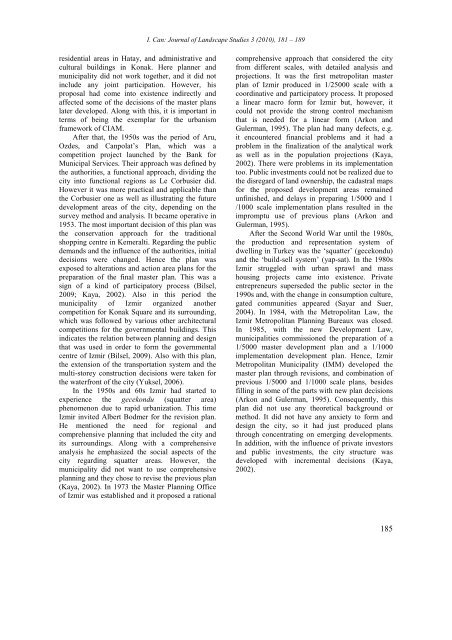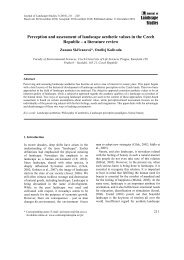Urban Design and the Planning System in Izmir - Centrum pro krajinu
Urban Design and the Planning System in Izmir - Centrum pro krajinu
Urban Design and the Planning System in Izmir - Centrum pro krajinu
You also want an ePaper? Increase the reach of your titles
YUMPU automatically turns print PDFs into web optimized ePapers that Google loves.
I. Can: Journal of L<strong>and</strong>scape Studies 3 (2010), 181 – 189<br />
residential areas <strong>in</strong> Hatay, <strong>and</strong> adm<strong>in</strong>istrative <strong>and</strong><br />
cultural build<strong>in</strong>gs <strong>in</strong> Konak. Here planner <strong>and</strong><br />
municipality did not work toge<strong>the</strong>r, <strong>and</strong> it did not<br />
<strong>in</strong>clude any jo<strong>in</strong>t participation. However, his<br />
<strong>pro</strong>posal had come <strong>in</strong>to existence <strong>in</strong>directly <strong>and</strong><br />
affected some of <strong>the</strong> decisions of <strong>the</strong> master plans<br />
later developed. Along with this, it is important <strong>in</strong><br />
terms of be<strong>in</strong>g <strong>the</strong> exemplar for <strong>the</strong> urbanism<br />
framework of CIAM.<br />
After that, <strong>the</strong> 1950s was <strong>the</strong> period of Aru,<br />
Ozdes, <strong>and</strong> Canpolat’s Plan, which was a<br />
competition <strong>pro</strong>ject launched by <strong>the</strong> Bank for<br />
Municipal Services. Their ap<strong>pro</strong>ach was def<strong>in</strong>ed by<br />
<strong>the</strong> authorities, a functional ap<strong>pro</strong>ach, divid<strong>in</strong>g <strong>the</strong><br />
city <strong>in</strong>to functional regions as Le Corbusier did.<br />
However it was more practical <strong>and</strong> applicable than<br />
<strong>the</strong> Corbusier one as well as illustrat<strong>in</strong>g <strong>the</strong> future<br />
development areas of <strong>the</strong> city, depend<strong>in</strong>g on <strong>the</strong><br />
survey method <strong>and</strong> analysis. It became operative <strong>in</strong><br />
1953. The most important decision of this plan was<br />
<strong>the</strong> conservation ap<strong>pro</strong>ach for <strong>the</strong> traditional<br />
shopp<strong>in</strong>g centre <strong>in</strong> Kemeralti. Regard<strong>in</strong>g <strong>the</strong> public<br />
dem<strong>and</strong>s <strong>and</strong> <strong>the</strong> <strong>in</strong>fluence of <strong>the</strong> authorities, <strong>in</strong>itial<br />
decisions were changed. Hence <strong>the</strong> plan was<br />
exposed to alterations <strong>and</strong> action area plans for <strong>the</strong><br />
preparation of <strong>the</strong> f<strong>in</strong>al master plan. This was a<br />
sign of a k<strong>in</strong>d of participatory <strong>pro</strong>cess (Bilsel,<br />
2009; Kaya, 2002). Also <strong>in</strong> this period <strong>the</strong><br />
municipality of <strong>Izmir</strong> organized ano<strong>the</strong>r<br />
competition for Konak Square <strong>and</strong> its surround<strong>in</strong>g,<br />
which was followed by various o<strong>the</strong>r architectural<br />
competitions for <strong>the</strong> governmental build<strong>in</strong>gs. This<br />
<strong>in</strong>dicates <strong>the</strong> relation between plann<strong>in</strong>g <strong>and</strong> design<br />
that was used <strong>in</strong> order to form <strong>the</strong> governmental<br />
centre of <strong>Izmir</strong> (Bilsel, 2009). Also with this plan,<br />
<strong>the</strong> extension of <strong>the</strong> transportation system <strong>and</strong> <strong>the</strong><br />
multi-storey construction decisions were taken for<br />
<strong>the</strong> waterfront of <strong>the</strong> city (Yuksel, 2006).<br />
In <strong>the</strong> 1950s <strong>and</strong> 60s <strong>Izmir</strong> had started to<br />
experience <strong>the</strong> gecekondu (squatter area)<br />
phenomenon due to rapid urbanization. This time<br />
<strong>Izmir</strong> <strong>in</strong>vited Albert Bodmer for <strong>the</strong> revision plan.<br />
He mentioned <strong>the</strong> need for regional <strong>and</strong><br />
comprehensive plann<strong>in</strong>g that <strong>in</strong>cluded <strong>the</strong> city <strong>and</strong><br />
its surround<strong>in</strong>gs. Along with a comprehensive<br />
analysis he emphasized <strong>the</strong> social aspects of <strong>the</strong><br />
city regard<strong>in</strong>g squatter areas. However, <strong>the</strong><br />
municipality did not want to use comprehensive<br />
plann<strong>in</strong>g <strong>and</strong> <strong>the</strong>y chose to revise <strong>the</strong> previous plan<br />
(Kaya, 2002). In 1973 <strong>the</strong> Master <strong>Plann<strong>in</strong>g</strong> Office<br />
of <strong>Izmir</strong> was established <strong>and</strong> it <strong>pro</strong>posed a rational<br />
comprehensive ap<strong>pro</strong>ach that considered <strong>the</strong> city<br />
from different scales, with detailed analysis <strong>and</strong><br />
<strong>pro</strong>jections. It was <strong>the</strong> first metropolitan master<br />
plan of <strong>Izmir</strong> <strong>pro</strong>duced <strong>in</strong> 1/25000 scale with a<br />
coord<strong>in</strong>ative <strong>and</strong> participatory <strong>pro</strong>cess. It <strong>pro</strong>posed<br />
a l<strong>in</strong>ear macro form for <strong>Izmir</strong> but, however, it<br />
could not <strong>pro</strong>vide <strong>the</strong> strong control mechanism<br />
that is needed for a l<strong>in</strong>ear form (Arkon <strong>and</strong><br />
Gulerman, 1995). The plan had many defects, e.g.<br />
it encountered f<strong>in</strong>ancial <strong>pro</strong>blems <strong>and</strong> it had a<br />
<strong>pro</strong>blem <strong>in</strong> <strong>the</strong> f<strong>in</strong>alization of <strong>the</strong> analytical work<br />
as well as <strong>in</strong> <strong>the</strong> population <strong>pro</strong>jections (Kaya,<br />
2002). There were <strong>pro</strong>blems <strong>in</strong> its implementation<br />
too. Public <strong>in</strong>vestments could not be realized due to<br />
<strong>the</strong> disregard of l<strong>and</strong> ownership, <strong>the</strong> cadastral maps<br />
for <strong>the</strong> <strong>pro</strong>posed development areas rema<strong>in</strong>ed<br />
unf<strong>in</strong>ished, <strong>and</strong> delays <strong>in</strong> prepar<strong>in</strong>g 1/5000 <strong>and</strong> 1<br />
/1000 scale implementation plans resulted <strong>in</strong> <strong>the</strong><br />
im<strong>pro</strong>mptu use of previous plans (Arkon <strong>and</strong><br />
Gulerman, 1995).<br />
After <strong>the</strong> Second World War until <strong>the</strong> 1980s,<br />
<strong>the</strong> <strong>pro</strong>duction <strong>and</strong> representation system of<br />
dwell<strong>in</strong>g <strong>in</strong> Turkey was <strong>the</strong> ‘squatter’ (gecekondu)<br />
<strong>and</strong> <strong>the</strong> ‘build-sell system’ (yap-sat). In <strong>the</strong> 1980s<br />
<strong>Izmir</strong> struggled with urban sprawl <strong>and</strong> mass<br />
hous<strong>in</strong>g <strong>pro</strong>jects came <strong>in</strong>to existence. Private<br />
entrepreneurs superseded <strong>the</strong> public sector <strong>in</strong> <strong>the</strong><br />
1990s <strong>and</strong>, with <strong>the</strong> change <strong>in</strong> consumption culture,<br />
gated communities appeared (Sayar <strong>and</strong> Suer,<br />
2004). In 1984, with <strong>the</strong> Metropolitan Law, <strong>the</strong><br />
<strong>Izmir</strong> Metropolitan <strong>Plann<strong>in</strong>g</strong> Bureaux was closed.<br />
In 1985, with <strong>the</strong> new Development Law,<br />
municipalities commissioned <strong>the</strong> preparation of a<br />
1/5000 master development plan <strong>and</strong> a 1/1000<br />
implementation development plan. Hence, <strong>Izmir</strong><br />
Metropolitan Municipality (IMM) developed <strong>the</strong><br />
master plan through revisions, <strong>and</strong> comb<strong>in</strong>ation of<br />
previous 1/5000 <strong>and</strong> 1/1000 scale plans, besides<br />
fill<strong>in</strong>g <strong>in</strong> some of <strong>the</strong> parts with new plan decisions<br />
(Arkon <strong>and</strong> Gulerman, 1995). Consequently, this<br />
plan did not use any <strong>the</strong>oretical background or<br />
method. It did not have any anxiety to form <strong>and</strong><br />
design <strong>the</strong> city, so it had just <strong>pro</strong>duced plans<br />
through concentrat<strong>in</strong>g on emerg<strong>in</strong>g developments.<br />
In addition, with <strong>the</strong> <strong>in</strong>fluence of private <strong>in</strong>vestors<br />
<strong>and</strong> public <strong>in</strong>vestments, <strong>the</strong> city structure was<br />
developed with <strong>in</strong>cremental decisions (Kaya,<br />
2002).<br />
185






